
- O’pen Skiff Purchase Page
- ILCA – Element 6
- RS Sailboats
- Sunfish – Recreational
- Sunfish – Race Version
- Sunfish Sails
- LaserPerformance Sunfish Parts Price List
- 420 – Zim Sailing
- Finding the Right Laser Rig: Formula
- Racks by Dynamic Dollies and Racks
- Load Rite Trailers
- Load Rite Sunfish Trailer
- **NEW** LoadRite for Sailboats
- Sunfish Dolly by Dynamic
- Optimist Dolly by Dynamic
- How to Apply Laser Sail Numbers
- Applying Laser Sail Numbers
- North Sails for LaserPerformance Dinghies
- About/Contact

Sail, row, or motor; the Bahia has it all. The Bahia’s versatile design provides a great platform for leisure or racing for the whole family. Slow to invert, and easy to right and re-board the Bahia makes safety one of its strongest features. Ideal for weekend adventures, the Bahia is comfortably beached, rowed or motored without compromising performance. And with a simple addition of a trapeze kit and a hoist of the gennaker, you’re off to the races!

Share this:
- Click to email this to a friend (Opens in new window)
- Click to share on Facebook (Opens in new window)
- Click to share on Twitter (Opens in new window)
- Click to print (Opens in new window)
- Click to share on Pinterest (Opens in new window)
- Click to share on LinkedIn (Opens in new window)
- Click to share on Tumblr (Opens in new window)
- Click to share on Reddit (Opens in new window)
Description
- Reviews (0)

BAHIA – Production now started at Ocean Play – Available Spring of 2023 – Pricing TBD
Row, sail, or motor. The Bahia was designed with stability, safety and performance in mind. It was created for leisure and ease of use, but not at the expense of performance. Stability and sturdy hull design make it easy to motor or row. The Bahia comes with a single line reefable mainsail for added sailing comfort in a breeze.
- Safety: With a stable and spacious cockpit, the Laser Bahia features clutter-free space for up to five adults. Inboard seats and controllable power allow the sailor to feel safe and secure throughout the ride. Should you capsize, the Laser Bahia is slow to invert, easy to right and re-board. When you add the mast head flotation, the boat sits smartly on top of the water so even a small person can right it with ease.
- Simplicity: Jo Richards has designed another boat that follows the well-balanced and hugely successful Vago and Pico. Jo has taken that success to design the ideal family boat. The extra high boom and gnav system leave the cockpit simple and efficient for new sailors. The furling jib and single line reefing system also makes it easy to reduce sail area if the breeze picks up.
- Performance: The light hull and large gennaker allow the Bahia to fly across the water. Add the trapeze option and you take the boat to the next level.
- More than just a sailboat: The multifunctional Laser Bahia can be sailed, rowed or motored. The stability and sturdy design of the hull make it a breeze to motor or row if the wind lays low. Also, you can add the stern storage box to store the engine or take goodies for a day trip.
- Single line reefable main for added sailing comfort when the breeze picks up
- Rotomolded 3-layer superior linear polyethylene hull
- Custom galvanized hand trolley included !
The Bahia has a white hull and deck, gray mainsail, and white jib. The optional asymmetric spinnaker is red.

The ultimate versatile daysailer for leisure or race.
Rigging a Bahia:
BahiaRiggingManual
Contact us for more information or to order your Bahia:
There are no reviews yet.
You must be logged in to post a review.
Related products

O’pen Skiff

Sunfish – Recreational

Laser – LaserPerformance
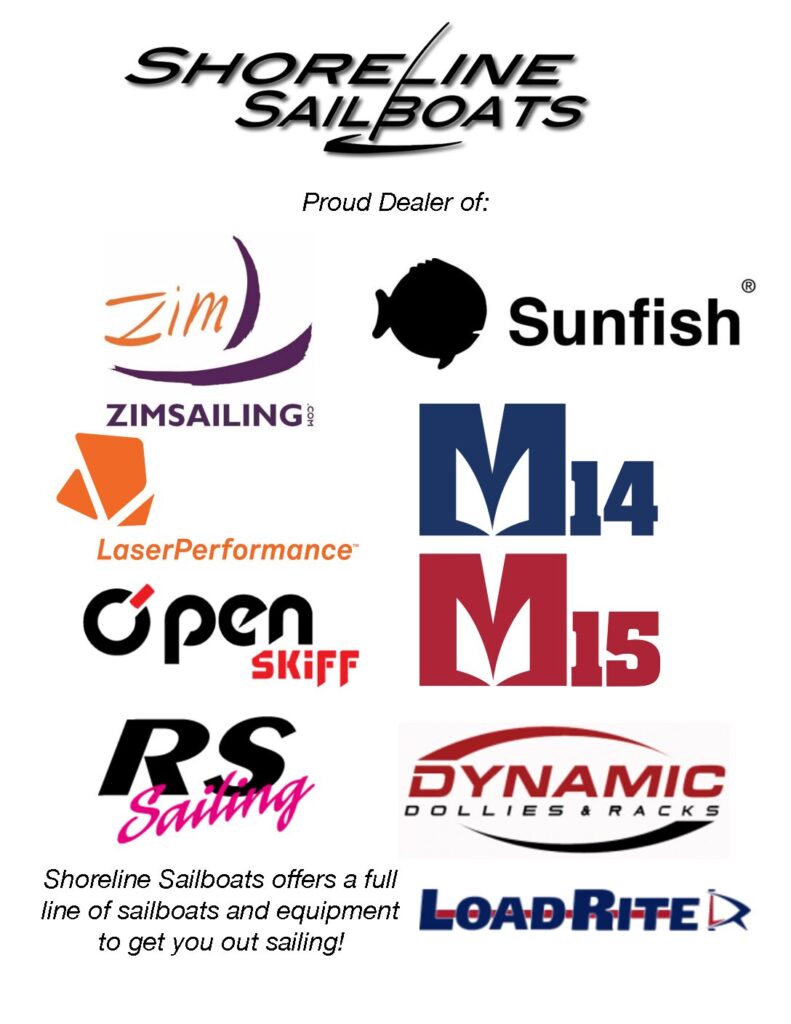
THE MELGES 15!
THE ROCKET! Built in the USA
SUNFISH – SAIL A CLASSIC!
Recent Posts

Hours & Info
Search products.
Contact us:
Any questions about the sailboats we sell, or the services we provide? We’re always eager to talk sailing and would enjoy helping you with any of your sailing needs. Contact Us
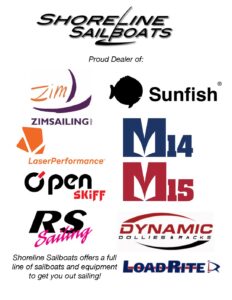
Designed by WPZOOM

The Sunfish combines easy rigging and manageability for a comfortable and hassle-free sailing experience. This is the sailboat loved by all. Designed in 1952 as the ultimate beach craft, the Sunfish sailboat is still a favourite with all ages. This maintenance free boat holds its resale value thanks to its robust construction, highlighted by hard chines and a flat underbody. The Sunfish can be stored almost anywhere and is a snap to car-top, making it a popular international class and easy to transport to your favourite beach for family fun.
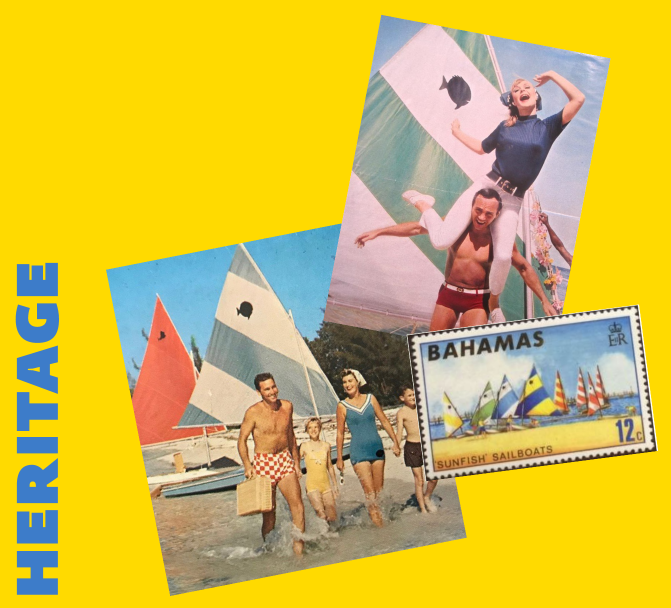
The Sunfish has its roots planted firmly in 1947 in Waterbury, Connecticut. Friends Alexander “Al” Bryan and Cortlandt “Cort” Heyniger (the Al and Cort in Alcort) pondered, “How to put a sail on a surfboard?” The answer involved a rejected design for American Red Cross waterfront rescue surfboards, leading to the Sailfish – a lateen rigged, flat-decked, plywood marvel. In 1951, Bryan’s pregnant wife found its flat deck somewhat uncomfortable. The addition of a cockpit and widening of the hull created the Sunfish. The logo was created by Heyniger, who traced a nickel and added fins, the tail and an eye. Early wood Sailfish and Sunfish were available assembled or as kits. In 1959 the introduction of fiberglass and the low cost and ease of production led to the proliferation of Sunfish everywhere. Other improvements included aluminium spars replacing spruce, Dacron sails replacing cotton, ash replacing mahogany for tillers, resulting in increased speed, performance and reliability. Sunfish racing started almost as quickly as two or three boats came together – the first North American Championship was 1963, the first Midwinters was 1965.

1 Hull – 2 Versions
Race – A strict one design international sail class
- Adjustable downhaul
- Adjustable outhaul
- Performance ratchet block
- Performance sailcloth
Recreational – For the ones exclusively looking for the pleasure of sailing a extremely simple and fun dinghy
- Colourful sails
- Even more simple to rig
- Reduced time to water
- Sailing made simple
The Sunfish is a sailing icon
One of sailing’s best-known brands, it is unmatched in simplicity and performance making it popular for all ages and abilities. With more than 60 years in production and sailed by celebrities such as the Kennedy and Paul McCartney, the Sunfish is the most popular sailboat in history.
- SUNFISH RACE
60 ft 2 5.58 m 2
13.9 FT 4.24M
4.1 FT 1.25 M
2.11 FT 0.64 M
Beginner->Expert
Club->International
BOAT LIGHTNESS
TIME TO WATER
SKILL LEVEL

PARTS LOCATOR
RIGGING MANUAL
- Parts & Accessories
Privacy Overview

Published on December 1st, 2021 | by Editor
Fifty years of Laser sailing
Published on December 1st, 2021 by Editor -->
When the Laser boat emerged in the 1970s, it was a gateway drug to the world of sailing. Go anywhere, launch anywhere, race anywhere. Adults and youth sailors alike, it initiated a worldwide generation that continues today.
During the pandemic in 2020, it was the solution to social distancing, with dusty gear finding the water again. And in this era of age-based youth sailing, the Laser offers inter-generational competition, bringing all ages together for learning and living.
Mark Lammens remembered when it all began, and the experience created the foundation in which his impact on Canadian sailing has been profound, earning him the Sail Canada President’s Award for his contributions to the sport.
In this report, Mark shares his 50 years of Laser sailing:

When I was 12 my parents were thinking about getting me a boat. Sailing school was fun and going well in Flying Juniors, so my dad bought the plans to build a marine plywood OK dinghy in our basement.
He was very handy and built a Snipe as our first family boat years back. At the same time. the Laser just came out and was built an hour away from where we lived. They decided to spend the $795 on a brand new red Laser, #8525. The boat was simple, affordable, and fun.
The boat came with a modern name, polypropylene traveler, mahogany blades, a 3.2 oz Elvstrom sail, and Elvstrom ratchet block. It came with a wooden tiller, a short extension, brummel hooks on a clew tie down and system ropes you would see on a keel boat. It also had high quality metal gudgeons and wooden hand rails that never broke.
That summer my instructor brought me to a regatta in Montreal with 210 Lasers. Before long, there were 20 Lasers at the club.
The concept and design came from Canadians Bruce Kirby (designer), Ian Bruce (builder), and Hans Fogh (sail and rig). All three were successful Olympic sailors and saw a need for a boat that provides simple sailing for everyone. The Laser class rules embraced the one design manufactured provided boat approach to ensure fairness in racing and simplicity, though this might have slowed down the introduction of needed improvements like an auto bailer, metal fairleads, durable sail cloth, and a better ratchet block.
The boats built back then had a wide option of colors like blue, mustard, red, and yellow. Because it was marketed as a roof topper with a 2 part non-tapered simple aluminum mast, lower top sides and 130 pound +/- weight, the Laser could be easily transported on the roof of the big cars of the time. Although there was a major uptick in singlehanded racing, the boat became very popular with the cottage community as many thousands of them were bought for the weekends on the lake. By the end of 1981, a 100,000 were built.
A big part of launching was having a friend help carry the boat in and out of the water or dragging it up the beach. Marketing the ease of transportation and storage might have delayed the introduction of a portable dolly which came later from Peter Siedenburg, a Finn sailor in Toronto who saw the need and designed the Seitech Dolly.
There was also a wide range of variables like all up weight and mast rake, and it took 15-20 years for some improvements like low profile tiller, thimbles for mechanical advantage on restricted rope systems, and better quality ropes.
The first smaller sail option was called the M rig which used the standard rig bottom section with a shorter top section with a halyard. M stood for Modified or Mini, but it was really a mistake. It was very difficult to de-power when the wind came up as the mast would not bend.
The better option was the Radial rig in 1983 with a smaller bottom section and the same top section developed by Fogh. There were many challenges with the smaller bottom section as it had to be able to bend and not break. Sleeves inside the mast and a thinner wall section seemed to help allow mast bend and also not break at deck level.
The Radial boat was ultimately named after the radial sail. The sail radiated from the clew and the sail cloth needed to stretch along with the bendy mast to have the mast/sail work together. Pulling on the downhaul to depower was hard on the sail cloth durability. A better longer lasting sail like the new standard Mark 2 sail is still an issue. Sailors that are campaigning in this class have a significant sail equipment expense.
There was another option for younger and lighter sailors, the 4.7. It was designed in 2005 with a much smaller 4.7 square meter sail with an even smaller bottom section. The bottom section has a permanent bend at deck level to ensure the sail is over top of the centerboard for steering balance.
The Class Association was committed to promoting racing, ‘Sailing is Fun’ and the new go fast techniques with the member newsletter. All sailors were new to the boat and an environment of collective improvement and sharing information was the mantra of the class.
Publications such as ‘Beam Reach’ and ‘the Laser Sailor’ had district reports, regatta results, and many tips from coaches and champions to keep the class engaged and informed.
The Laser came before the invention of many products that make sailing easier. Waterproof sunscreen, Gore-Tex, rash guards, McLube, Gatorade, no stretch non-absorbing non-tangling Rooster rope, chill guards, Zhik life jackets, and energy bars were many years away. Good hiking boots, quick dry technical clothing, merino wool, and the introduction and improvement in neoprene for hiking pants and cold water sailing was also years away.
A complicated and contentious patent, royalty, and international availability issue required a boat name change from Laser to ILCA to maintain Olympic status.
Today’s equivalent Laser boat, the ILCA 7 has a carbon fibre top section option, 4.5 oz sail, tapered battens, non-slip hiking strap, electronic compass, and properly oriented harken rigging systems that can be adjusted from hiking position. With the boat’s World Sailing international status, it has national three letter identifiers plus national flag.
In 1996, 25 years after the first boats went into production, Olympic status was awarded for the Laser, followed in 2008 for the Radial. Today the Singlehanded Men’s class at the Olympics is now the ILCA 7 and the Singlehanded Women’s class is the ILCA 6.
The simple, widely available, consistently constructed boat with a two-part mast ensures that racing is testing the ability and fitness of the sailor. As a British journalist once commented on boats, “the Laser (ILCA) is a proper little yacht.”
Perhaps in light of that the class would consider bringing back metal gudgeons, hand rails that don’t break, and design a new longer lasting sail for the Women.

Tags: ILCA , Mark Lammens
Related Posts
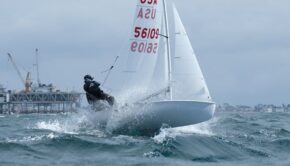
ILCA, 29er, and I420 Midwinters West →
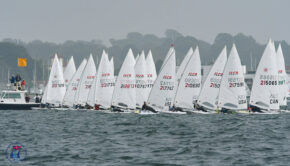
Love letter from the back of the fleet →
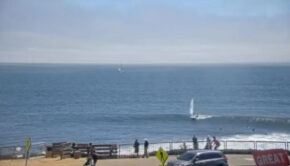
VIDEO: ILCA surfing at Steamer Lane →

PHOTOS: Fall racing in Marblehead →
© 2024 Scuttlebutt Sailing News. Inbox Communications, Inc. All Rights Reserved. made by VSSL Agency .
- Privacy Statement
- Advertise With Us
Get Your Sailing News Fix!
Your download by email.
- Your Name...
- Your Email... *
- Phone This field is for validation purposes and should be left unchanged.

⛵️ Fast Dispatch - Getting You Back on the Water ⛵️

- Gelcoat Fillers
- Dry Lubricants
- Adhesive Glues
- Hooks & Clips
- Catamaran Launching Trollies
- Jockey Wheels
- Hitch Locks
- Lighting Board
- Breakaway Cables
- Clew Straps
- Upper Masts
- Lower Masts
- Rope Thimbles
- Wind Indicators & Burgees
- Parrel Beads
- Whipping Twine
- Sailmakers Palm
- Digital Compasses
- Laser Products
- Numbers & Letters
- Dinghy Covers
- Under Covers
- Catamaran Covers
- Single Handed
- Double Handed
- 18 Foot Skiff
- Exocet Moth
- Musto Skiff
- Dart 15/ Sprint 15
- Hurricane 5.9
- Laser Bahia
- Laser Cascais
- Laser Funboat
- Laser Stratos
Your Cart is Empty
- £0.00 Subtotal
Tax included and shipping calculated at checkout
Order before midday Monday to Friday and we will ship your order the same day.
- 01268 222912
- Accessories
- Sails & Covers
- Rope Lengths
- Parts By Boat
- Boat Care & Cleaning
- Splicing Tools
- Boat Covers
- Dinghy Rope Lengths
- Laser Rope Lengths
- RS Rope Lenghts
- Catamaran Rope Lengths
- Laser Performance
- Topper Sailboats
- Other Boats

- Mens Sailing Clothing
- Womens Sailing Clothing
- Repair Kits
- Skiff Suits
- Life Jackets
- Trapeze Harnesses
- Buoyancy Aids
- Hiking Pads & Pants
- Hiking / Toe Straps
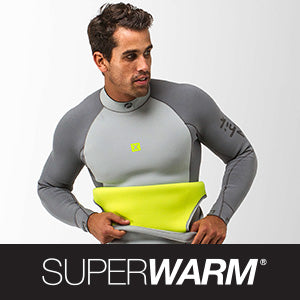
Zhik Superwarm
- 100m Rope Reel
- Polyester Ropes
- Control Lines
- Double Braids
- Braid On Braid
- Anchor Lines & Ropes
- Spools & Reels
- Windsurfing
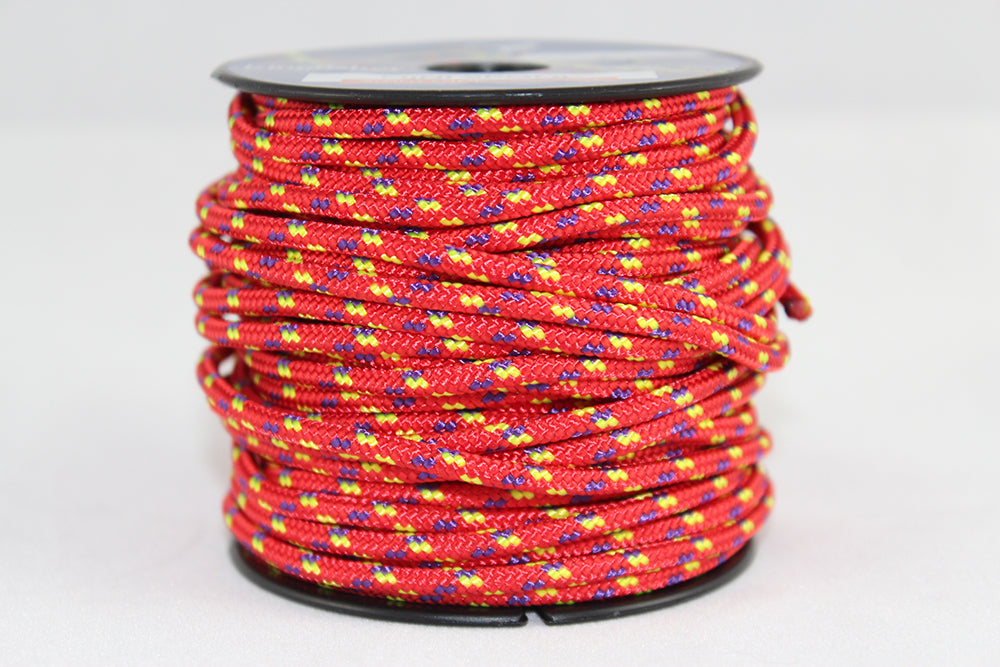
Mini Spools
- Single Block
- Double Block
- Triple Block
- Soft Attach
- Split Rings & Pins
- Inspection Hatches & Covers
- Bungs & Sockets
- Rudder & Tiller Parts
- Bushes & Fairleads
- Marine Screws
- Penny Washers
- VHF Aerials & Antennas
- Marine Tapes
- Traveller Systems And Parts
- Traveller Blocks
- Pico Hull & Deck Fittings
- Hull & Deck Fittings
- Laser Boats
- Laser Sails
- Laser Sail Packages
- Laser Spars
- Laser Rig Packages
- Laser Foils
- Laser Hull & Deck Fittings
- Laser Ropes
- Laser Dinghy Covers
- Devoti ILCA Boats
- ILCA Sail Packages
- ILCA Rig Package
- Devoti KDK Boats
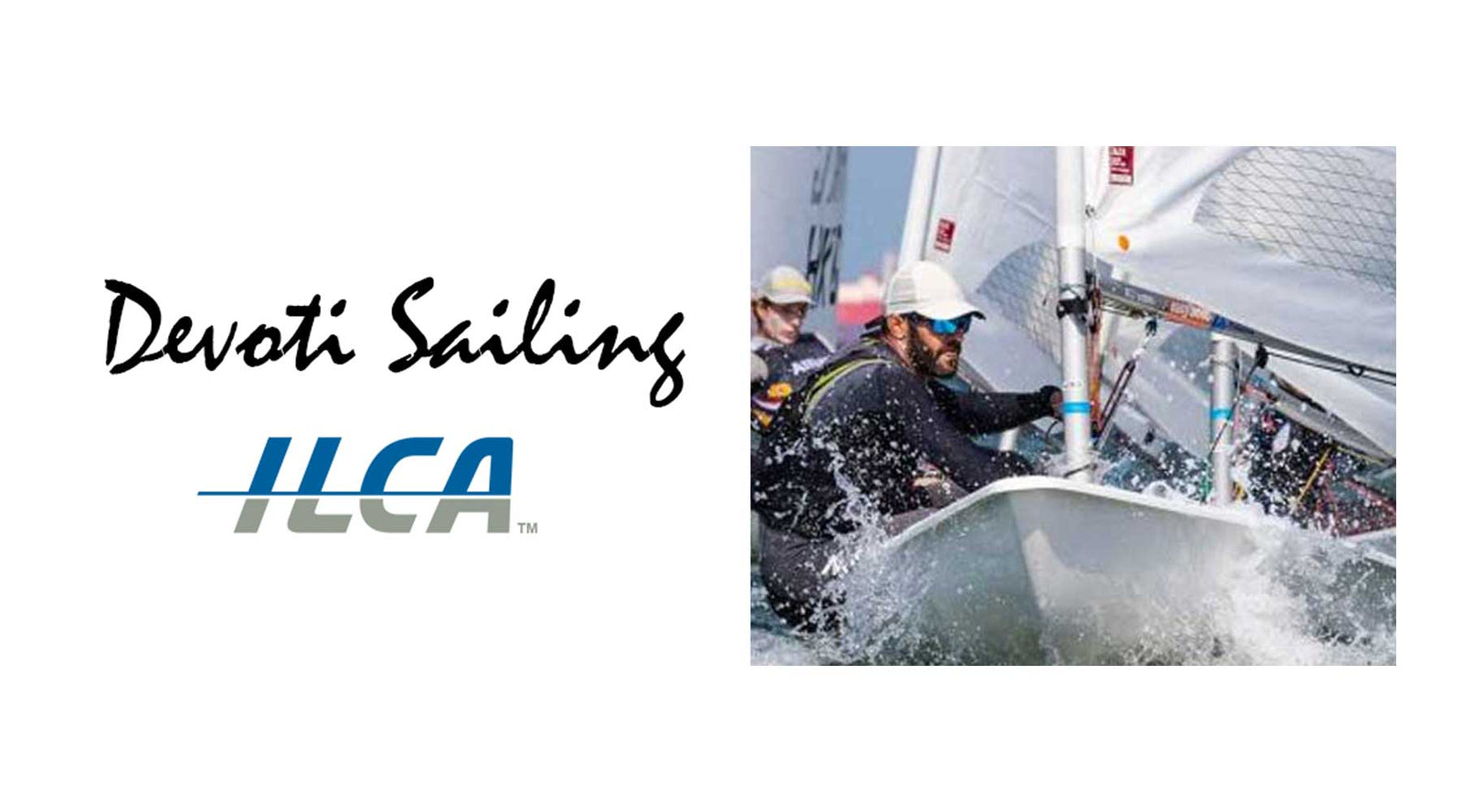
New Devoti ILCA
Search our chandlery
🚚 Fast Dispatch and a 5 Star Rated Service You Can Count On ✅

Laser Sailing - How to get started
August 17, 2018 4 min read
So, you're looking into Laser Sailing but maybe you're not sure how to get started with buying a Laser and keeping it sailing. Well you've come to the right place, as an authorised Laser Performance boat and parts dealer we can help.
First of all, it's important to say the Laser is a great boat, first introduced at the 1971 New York Boat Show it's gone from strength to strength with it being the choice of Olympic sailing for both men and women and with over 200,000 being built to date. In the UK there is a very active class association with events up and down the country with hundreds of boats attending the larger events.
Laser Sailing Boat Key Facts
- Year of design - 1969
- No of sailors - 1
- Draft - 0.787m
- Hull weight - 58.97kg
- LWL - 3.81m
- Beam - 1.39m
- Rig types - Standard (full rig), Radial and 4.7

Buying a Laser Sailing Dinghy
There are two options when buying a new Laser sailing dinghy.
The large majority of people starting off with a Laser will buy second hand, there are a number of places in the UK where you can source a second hand Laser, here are just some examples:
- Apollo Duck
- Dinghies and Dinghy Bits for Sale Facebook Group
- Yachts and Yachting Magazine
- Club Notice Boards - worth looking at a busy Laser Sailing club
If you are thinking of buying a new boat then you've come to the right place. Sailing Chandlery have boats readily available and can tailor a package to suit your sailing needs.
The easiest way to get started is to review the Laser boats for sale on our website along with prices and then give us a call to tailor your package.
You can call us on 07793 953564.
Which Laser rig?
The superb thing about the Laser is that it can be a boat for many different people and is especially a great boat for smaller youth sailors who will grow over time and can simply swap in and out the three different rig options.
The rigs available are:
- Laser Standard - traditionally for men
- Laser Radial - traditionally for lady and youth sailors
- Laser 4.7 - traditionally for youth sailors

Although the above is what has typically happened in the past we've seen plenty of female and youth sailors sailing a Laser standard, it's simply down to personal preference. You could have a full (standard) rig for light winds and then a radial for the windier days.
You'll save a bit of money on a Laser 4.7 sailing boat because the sail is slightly cheaper. The radial and standard sails are the same price so the boat package prices do not differ.
What's included with a new Laser boat?
Many Laser dealers (Laser Performance included) will give you a price that looks attractive until you realise that a launching trolley and boat cover isn't included. For us these are essentials for when you're buying a new boat so we've created packages which include these essential items.
If you were to buy a package from Sailing Chandlery you would receive the following:
- Spars to include mast sections (depending on rig chosen) and boom
- Carbon composite top mast section
- Tiller and tiller extension
- Class Legal Sail (depending on rig chosen)
- All blocks and pulleys needed
- Launching trolley
- PVC boat cover (polycotton breathable covers are also available as an extra)
This is essentially everything you need to get sailing and to start to enjoy your brand new Laser.
Additional options such as different sized rigs, road trailer, under cover and much more are also available - let us tailor a custom package for you, you won't be disappointed.
Spare Parts
Have you bought an older boat and need to get it refreshed?
As one of only a few official Laser Performance dealers in the UK we are able to help and carry a large range of Laser parts and spares in stock ready for dispatch.
In our experience, the most popular upgrades for a Laser purchased second hand are:
- XD kit upgrade - many older Lasers still have the traditional control line systems
- New sail - there are three different types of sail - Training, Class Compliant and Class Legal - you might not need to spend the money on an official class legal sail
- Different rig - we provide rig packages so you can get everything you need as one tailored product
- Zhik Laser Toe Strap
Time to Learn
This is all about time on the water, get out there, start sailing and enjoy the Laser sailing dinghy.
If you want the best reading on the Laser we would recommend The Laser Book.
Got questions? We're always happy to help, whatever the question please contact us and ask away.
Recent Articles
- Pre season Check List
- Where Should My ILCA Tell Tales Go
- What Are The Basic Tools Needed To Start Rope Splicing?
- You Don't Always Need Dyneema
- Boat Care and Cleaning Products
- Ropes for Club Boats and Club Dinghies - The Bosuns Guide
- Why You Should Use Two Sailing Watches
- Setting Your ILCA Dinghy Controls Up For Success
- 7 Items To Make Your Boat Go Faster in 2023
- Rope Termination to Retain The Most strength
Let customers speak for us
I ordered a rope bag for learning knots this item arrived quickly and is much appreciated
Top Notch Service !👍
Great addition to our training fleet - good product backed up by brilliant delivery. Thanks.
Perfect for the job!
These were recommended to put on over my Gill dry suit. Bought a size bigger. We’re a bit tight but getting better, easy to pull on and off with the heel tab. Good soles and grip well on my board. My feet are so much warmer so I can go out most of the year.
Rope offcut easily ordered, as described, and prompt delivery. Good service all round
Delivered very promptly and well packaged, worth the shipping charge to not have to fetch it. Haven't sailed with it yet but have rigged it with the outhaul fittings and everything seems fine.
It is a good buoyancy-aid it has a nice size pocket and is really comfortable to wear. They also have fast delivery and great customer support thanks Jason.
I bought these hoping they be ok as prizes for our Topper Traveller, but was concerned they wouldn’t be robust given the price (in which case the 3 sailors in the family would get them). I was happy when they arrived. They are more robust than I thought, and super lightweight, but with a grippy palm part. They’ll be great for use in the summer on their own (lighter than neoprene) but robust enough to protect hands, but also good enough to be used as a base layer in the winter. Happy that we were able to use as prizes.,
It’s stretchy and can tie in knots.
Does the job
SIGN UP TO OUR NEWSLETTER
Save up to 40% on your next order.
Discover how to start the sport of Laser sailing with our step-by-step guide that quickly gets you onto the water.
Even with NO experience at all, we simplify the process to help you learn the basics of sailing , along with tips and techniques used by expert sailors. This means you can get the most out of your Laser Sailing Dinghy faster !
Beginners Guide to Laser Sailing
Below is some information to start laser sailing and what you should expect when you start.
Click on the links below to see handy tips and tricks to help you:

Tips on learning to sail a dinghy

Sailing theory to give you a better understanding of the basic principles

What to look for when buying your dinghy

The places to look for a laser dinghy for sale , and the best questions to ask

All the major controls and fittings on a Laser, and what they do

A step-by-step guide on how to tie all the knots on your Laser dinghy

How to rig your Laser sailboat

Launching your Laser dinghy, and your 1st sail

All the Laser sailing gear and sailboat accessories you need, and much more
Attention All Laser Sailing Newbies & Enthusiasts...
Laser Sailing Tips - helping you get the most out of your Laser dinghy
Enough with the contemplating! The perfect time to uncover the simple steps that will get you sailing has never been closer.
Without the advice shared here, you might find yourself investing more of your valuable time and hard-earned cash than necessary!
If your heart is set on diving into the world of Laser sailing , I have some exciting news for you.
Over nearly three decades, I've been mastering the art of sailing. In recent years, I've started Laser dinghy. Over that time I have spent countless hours learning about laser sailing by:
- talking to other keen sailors,
- reading the best sailing books,
- browsing other great sailing websites, and
- trial and error on the water...
to find the best ways to get up to speed in this great sport.
Here’s the good news… it doesn’t have to be like that for you!
Here at Laser Sailing Tips , we share many of the tips that beginners can use immediately to start the journey into Laser sailing.
Even if you are not a beginner, or if you sail other types of dinghies or even yachts, I am sure that you will be able to pick up some useful tips.
One of the great things about sailing is that there is always more to learn. Whether you are learning the basics of sailing or are at a more advanced level, learning from others is one of the best ways to speed up your knowledge.
And the best part is that this information is available to you FREE !!
So read on, and in no time you will be experiencing what 1000’s of others are experiencing… the enjoyment of sailing a Laser .
To your sailing freedom,
Brendan at LaserSailingTips.com
ps. I'd appreciate any feedback and ideas you may have for this site. Please contact us if you have your own laser sailing tips you'd like included, and we will recognize your contribution as expected.
pps. Send me any questions you have about Laser sailing. I always try to answer all questions.
ppps. I'd love it is you could share this information on Facebook and Twitter. Click on the sharing links on each page to share. The greater our efforts in broadening the reach of Laser sailing, the better 🙂
Next: About Laser Sailing Tips
Latest Sailing Products Reviews...
8 best boat shoes for women reviewed, the top 7 sailing hats for 2023, tahoe brim sailing hat review, 6 best laser sailing gear picks for 2023, top laser sailboat accessories & upgrades, 9 best sailing bags – sailing bag options, latest blog posts....

Maritime Myths: 30 Common Sailing Superstitions and Their Meanings
Last Updated on October 18, 2023 by Brendan Sailors, given the often unpredictable nature of the sea, have historically been a superstitious lot. Here are…

Last Updated on March 28, 2024 by admin You’ve heard the term ‘boat shoe’ or ‘deck shoe’ but do you really know what they are?…

Exploring the Different Types of Sailing
Last Updated on September 29, 2023 by Brendan When sailing you can encounter many different experiences… from excitement and adventure to relaxing and peaceful. Depending…

Last Updated on March 28, 2024 by admin The best sailing hats are generally made from lightweight, quick-drying fabrics. Some have cords you can use…

Sailing Exercises: Improve Your Fitness For Sailing
Last Updated on July 31, 2023 by Brendan Sailing is more than a water sport. It can be a grueling mental and physical workout. It…

Kids Sailing: 11 Reasons Why Your Child Should Learn To Sail
Last Updated on December 5, 2023 by Brendan In today’s technology-driven world, outdoor activities hold an important place in the development of children. Among the…
- Next »
Thanks for visiting Laser Sailing Tips.

46 Comments
Hi thank you for the site, it has aleady been really useful. My problem has been severe weather helm as the wind increases and it seems that increasing the downhaul tension should help this, I do have one further question that I was hoping that you could help me with. When we bought the boat it came with what is apparently a slightly shortened centreboard. How much do you think that this could affect the weather helm and could you tell me the correct length of a centreboard so that I can see how by how much it has been shortened. Thank you very much in advance. Paul Kench
Hi Paul Glad that you’ve found the site useful. I don’t think that the shortening of the centreboard a little would cause the weather helm that you mention. Sounds like you are just overpowered. As the wind increases, if you start heeling more, this will naturally tend to point the boat up into the breeze, causing the weather helm. Try flattening out the boat more using the cunningham, outhaul and vang. Hike out hard. This should help keep the boat flatter, reducing the weather helm, and increasing speed. As for the correct length of the centreboard, you may want to check out the current rules . Cheers and all the best! Brendan
Great site. A Really nice read. I’ve a quick question, I found myself in an uncomfortable situation not long ago. I was around 1 mile off shore practicing beats when the tide turned and the wind dropped to nothing (literally nothing). I couldn’t move the boat at all and gently bobbed with the tide drifting out to sea! Fortunately the wind rolled in and I was able to sail back but I spent a good 20mins I panicking! If I’m close to the shore I usually paddle the boat back. Do you know of any techniques to somehow get back in when you’re quite far out (as paddling 1 mile is likely beyond me)?
Hi Mark Thanks for your comments and question. Not a good spot to be in! I thankfully haven’t been out when there is absolutely no wind. Other than paddling I’m not sure what you can do. You can try moving the rudder from side to side which will push the boat forward – not ideal for large distances and probably doesn’t do your gear much good. Other than that, keep an eye out for any puffs of wind on the water that you may be able to use to your advantage, as well as any approaching motor boats and ask for a tow. Maybe some of the other readers have some suggestions?? Let us know if you discover anything more useful. All the best Brendan
Have you thought of strapping a kayak paddle (which can be broken in two) to the mast and using it for paddling home?
Also, if the current is not too strong you can make some progress (I suspect about an mile an hour) by standing on the bow an gunnel bobbing – rocking back and forth. This takes a bit of practice but it is effective.
I always carry a cell phone on board for emergencies. Excuse my English but I use google trasnlate.
Nice tip Fernando!
Takes some balance but take the main sheet in your hand and stand in front of the mast. Rock the boat side to side as much as you are comfortable. More the better. This should get you going a couple of knots once you get comfortable.
If you run out of wind, never paddle. You need to create your own wind by rocking the boat. One way is to stand up with one foot on either side of the deck, heel the boat over by loading up one foot, then roll the boat back by loading up the other foot. This will induce flow over the sail, and you will move forwards. The other, more advanced option, is to tie off the tiller, sheet in the main and quickly run onto the foredeck. Whilst holding the mainsheet in one hand and two hands on the mast, you can flop the mast from side to side with your hands and body and generate good speed. You steer by heeling the boat and using the shape of the hull to turn. Never paddle. It’s a waste of time and energy compared to rocking
Thanks Andrew. Sounds like it’s worth a try. Thankfully I’ve never been in that situation, but will give it a go if / when caught out next time.
What a site. Huge amount of info for one who wants to learn a bit about the boat before buying one. Extremly usefull. Thanks. I’ll be back to learn more!
hi Tiago Thanks for your comments. Glad you like it the site have found it useful. Good luck with your Laser sailing 🙂 cheers Brendan
Hi Brendan thanks for putting together such a great site. I’ve just bought a laser and am very keen to get out there sailing on Sundays at my local sailing club. Thanks to your articles I’m a little more prepared. The laser I bought does not have a turbo kit installed however I notice that most at the club do have them. What is your take on the benefits of a turbo kit at novice level? Col
hi Col Thanks for visiting my site and for your question. You definitely don’t need a turbo kit when you are just starting out. They are quite expensive, so if you are just testing to see whether you will continue with the sport, you can (as you have done) buy a boat without the turbo kit, and always upgrade at a later date. By installing the new blocks, cleats and control lines in the kit, it provides more purchase and easier access to the lines, making adjustment of the vang, cunningham and outhaul easier. This allows more precise tuning, which may give you the competitive edge. Hope this helps. Good luck with your laser sailing journey. All the very best. Brendan
Hi, what is the max speed of a laser? and how easy is it to get it there? Best regards Kresten
Hi Kresten Good question. There’s a lot of talk out there, but as for the maximum recorded speed, one site that I saw claimed it at 16.8 knots (click here ). On a broad reach in good conditions, I thought that would have been pretty reasonable to reach that speed. With some waves, I thought you’d be able to do that pretty easy 🙂
All of this site is excellent
Thanks Pacman, appreciate your feedback
highly nice post, i absolutely love this web site
Cheers Fred 🙂
Very interesting subject, appreciate it for putting up.
Thanks Garfield, I’m happy that that you found it useful.
Wow, that’s what I was exploring for, thanks admin of this website.
No problems, roofer. Glad you enjoyed it
I purchased a used Laser Pico and do not think the rigging on the boom is correct. I guess this is the outhaul. I need very clear step by step instructions. The instructions in the manual and on websites goes to fast for me. Are there any videos or step by step instructions just for this part??? Thank you, Seth
Hi Seth. Thanks for your question. I am not familiar with the pico, just the standard Laser, so can’t give you specific advice. If you can’t seem to get the setup right, or find info on YouTube, maybe head down to your local club and ask around. Sailors are generally a friendly and helpful bunch, and I’m sure that there will be plenty of people around that will be able to offer you the specific rigging advice you are after. Best of luck
My query concerns the launching trolley for a Laser Pico – very similar, I think, to the standard Laser trolley. The trolley is designed to support the boat by the gunwales rather than the keel as in trollies for most other types of dinghy. The problem is that the supports have separated so that they are wider apart that the gunwales and if one side is supported, the other support is outside the gunwale. There is no adjustment as it is all welded together. The trolley is otherwise in good condition. Does anyone have any suggestions as to how the supports can be drawn in by about 2-3 inches?
Hi Julian It’s a bit of an unusual problem. Not sure how this could happen. Presuming that the trolley did actually fit the dinghy at some stage, it must have been bent out of shape. Maybe a welder or a fitter and turner could bend it and / or re-weld it so that it would be at the the correct width again for your boat. Not sure if some other readers have seen / experienced this before, and can offer some advice. Hope you get it sorted. cheers Brendan
I just bought 1988 dingy laser. First time sailing in open water I only flipped it 3 times. It rights up well. I weigh 230. Anyway , I paid 1500.00 for laser dingy 4 sails two masts all rigging and dolly… Is this a good deal.?
Hi James. That’s a bit like saying “How long is a piece of string”. For me, it really depends on the condition. If it’s in great condition, with no soft spots in the hull, the spars, sails, foils and ropes are all good, then $1500 is probably pretty good. But if it’s at the other end of the spectrum, and it’s seen much better days, then it may not be such a good deal. There’s a fairly wide range in prices on the market, and a fairly wide range of condition with boats on offer… hence why I put this guide together. Anyway, hope that helps a little. cheers Brendan
do you or any of your readers have experience using a turbo sail on their laser. It is claimed to have 125 ft2 so it is a considerably bigger sail than the standard 76. My question or concern is since I own a laser from the 80’s, can the mast stem, mast, and rigging withstand the added stresses and forces from the larger sail. I love the thought of the additional speed especially with a crew of two but concerned about damage. thanks
Hi Charles I don’t have any experience with the turbo sail. I know that you can have issues with the mast step, so if there’s any extra forces in this area, it may lead to some problems. There’s an interesting discussion here , if you want some further reading. Maybe some of the other readers can help out. Cheers Brendan
Hi, I am 15 and a keen dinghy sailor having grown up into the business. Last year I began single handing in a topaz, sometimes using an asymmetric spinnaker by converting into a topaz race X. I also love to crew: fireball, merlin, cadet, mirror you name it! I am looking at moving out of the topaz and into a laser radial but will only have money from selling my topaz to buy a laser. a) is it a good idea to move into a laser? If not do you have any suggestions of single handers? b) do you think I could find a decent laser for that range? (My topaz is 2 years old, only been sailed for 1 year) Any help would be greatly appreciated, thanks
Hi Zoe Thanks for your questions. It’s great to see that you are so keen. Regarding your questions, in my opinion it depends on what you are after. Lasers are very popular, and because they are one-design you can generally find plenty of clubs around where there is quality racing each week. They can be raced right through from beginners up to advanced, so can cater for all abilities. They are not the fastest boat out on the water, but I think it’s the closeness of the racing that attracts so many people to them. Considering how old your topaz is, it should still get a decent price. You won’t be able to get a new laser for the same amount, but you should be able to get something pretty reasonable. There are generally plenty on offer, so just keep your eye out and let people know that you are looking for one, so they can keep an eye out too. By the sounds of it, you should have plenty of contacts at the clubs, so why not ask to take someone’s out for a spin one day so you can judge it for yourself. Also have a look around and see if there is anything else that catches your attention and maybe try them out too so that you can compare. All the best Brendan
Hey, I’m 16 and I weigh 215lbs, would I be competitive, if I were to get Into laser racing? Or is that to heavy to be competitive?
Hi James Yeah, 215 lbs is a bit heavy than most sailing the laser, so especially in the lighter breeze, you might struggle to keep up. If it’s generally quite breezy where you live, it might make it a bit easier for you though. Check out this thread for some more info… click here . Cheers Brendan
I just sailed my used laser for the first time. I noticed that I got a bit of water in the boat (not in the cockpit, but in the hull). I took the drain plug out in the stern of the boat and it drained out. What would cause this?
Hi Mike Thanks for your question. Water getting into the hull would most probably be from cracks. This can happen in a few ways. When your deck and hull gets soft, there can be tiny cracks that can allow water to penetrate. You can also get cracks in and around the mast step, fin case, plus where the deck and hull join together. So when you are buying your laser, always check out the stiffness of the deck. Also, a sign that there may have been repairs in the past is an inspection port. If the repair job was a bit dodgy, the inspection port or the repair job itself may leak a bit. And if you are keen and got some time up your sleeve, you can fill up the mast step and see if the water level drops. This may indicate a leak. Hope this helps a little. cheers Brendan
Hi, This is such a useful site! I was just wondering if there is anything in the laser class rules against painting your boat a different colour than “laser grey”. I have noticed that you see almost no lasers in different colours apart from laser grey. I thought it would be pretty cool to have a laser that has a unique colour but I thought I would just check here in case. Thanks again for the amazing site.
Cheers- Jackson
Hi Jackson Thanks for that… I really appreciate your comments. From what I understand, as long as you don’t make the hull lighter in weight to improve its performance, you should probably be ok. That being said, if you paint it, it will probably add to the weight, so (other than looking cool) it may have a negative effect. There is a bit of a discussion here , so make sure you check it out. All the best Brendan
I just got a 1976 Laser and I’m sure its a little soft and prob had repairs but for a couple of bucks it might help me learn to sail. I have had it out three time and I made it back to the dock all three times. It has also captsized and it rights up pretty easy. I was looking at parts as I need a new hiking strap and saw that plastic bottles for air are sold as a replacement for styrofoam. Looking through the inspection port I do not see anything to aid in floatation. Do I need these bottles? Will the boat sink without them? Thanks for your help.
Hi there No, you shouldn’t need any styrofoam, as the hull should be watertight, meaning that it won’t sink. It’s fairly common for older lasers to take on a bit of water, as they can form small cracks that can let a small amount of water in, but if it’s letting in enough water that you are worried about it sinking, then you might want to investigate further and get the leaks fixed. It might have more substantial cracks around the fin case or mast step. cheers Brendan
Hi, im an italian just land in sydney. i would like to have sometimes a nice sails on a laser. do you know someone who hire them? thank you all Fabio
Hi Fabio Thanks for your message. There are a few places that hire laser dinghies out, but many require you to be a member of the club first. So you may have to ask really nicely… you never know – you might get lucky 🙂 Check out these places:
- Double Bay Sailing Club
- Balmoral Water Sports – As far as Laser dinghies go, I think they only have Laser Picos
- Greenwich Sailing Club
Otherwise just wander down to the local clubs and ask around. Some of the locals may know of somewhere that can help out. If anyone knows of anywhere that rents Lasers, please leave details below. Enjoy your time in Sydney, and I hope that you have a great time out on the harbour. Regards Brendan
Hello I am a new laser sailing. I have had past experience in sailing the opti for the past 6 years. But it seems while I am training with the local race team I am going very slow compared to the other lasers. And im not sure why, we are all in ILCA 6/radial. Do you have any tips for boat handling?
Thanks for your message. It’s great to hear that you’re transitioning from Opti sailing to Laser sailing! The Laser is a great dinghy, but it can be quite different from the Opti in terms of handling and speed. Here are some tips to help improve your handling and performance in a Laser:
- – Body Positioning : Laser sailing requires careful attention to body positioning. Make sure your body is balanced in the boat. Keep your weight centered when sailing upwind, and hike out (lean out over the side of the boat) as much as possible when required to help control the boat’s heel and maximize speed.
- – Sail Trim : Pay close attention to your sail trim. Make sure your sail is set up correctly with the appropriate tension on the vang, downhaul, and outhaul. Adjust the sail shape and trim to match the wind conditions. Generally, you want a flatter sail in strong winds and a fuller sail in lighter winds. Check out the sail setup and angles of trim of other sailors.
- – Tacking and Gybing : Practice your tacks and gybes to minimize the time your boat spends off-course during these maneuvers. Smooth transitions are key to maintaining speed and control.
- – Starts and Mark Roundings : Start line tactics and mark roundings can make a significant difference to your race performance. Study race strategy and practice these situations with your local race team.
- – Fitness and Endurance : Laser sailing is physically demanding. Make sure that you’re in good all-round physical shape and work on your endurance, especially for longer races or windy conditions.
- – Learn from Others : Don’t hesitate to approach experienced Laser sailors in your area and ask for tips or even go out sailing with them. Observing how they handle the boat and their techniques can be really useful. Watch how others start, tack and gybe, as well as their body position and and sail setup.
- – Watch the water : Look for wind gusts and shifts. Try to keep your boat in breeze, so this might mean favoring one side of the course, or tacking before sailing into a lull in the breeze. As you sail into a knock, you might want to tack to get a better sailing angle.
- – Keep Learning : Laser sailing is a continuous learning process. Attend clinics, watch Youtube videos, and read books on Laser sailing to gather more insights and improve your skills. Then practice what you have just learned to better understand it. There are also plenty of resources on this website, so make sure that you check them out.
- – Mental Toughness : Sailing can be mentally challenging. Stay positive, learn from your mistakes, and maintain focus during races.
- – Safety : Always prioritize safety. Wear appropriate gear and be aware of weather conditions and potential hazards on the water.
This is not an exhaustive list, but as you can see, there are a lot of things that you can do to improve your performance. I am sure that others may have some other ideas on things that you can do as well. Remember that Laser sailing is a highly competitive sport, and perfecting the basics and overall improvement takes time and practice. Be patient with yourself, and keep working on your skills. Best of luck with your Laser sailing, and I hope these tips help!
Leave a Comment Cancel Reply

Step-by-Step Guide: Learn How to Rig a Laser Sailboat for Optimal Performance
Alex Morgan
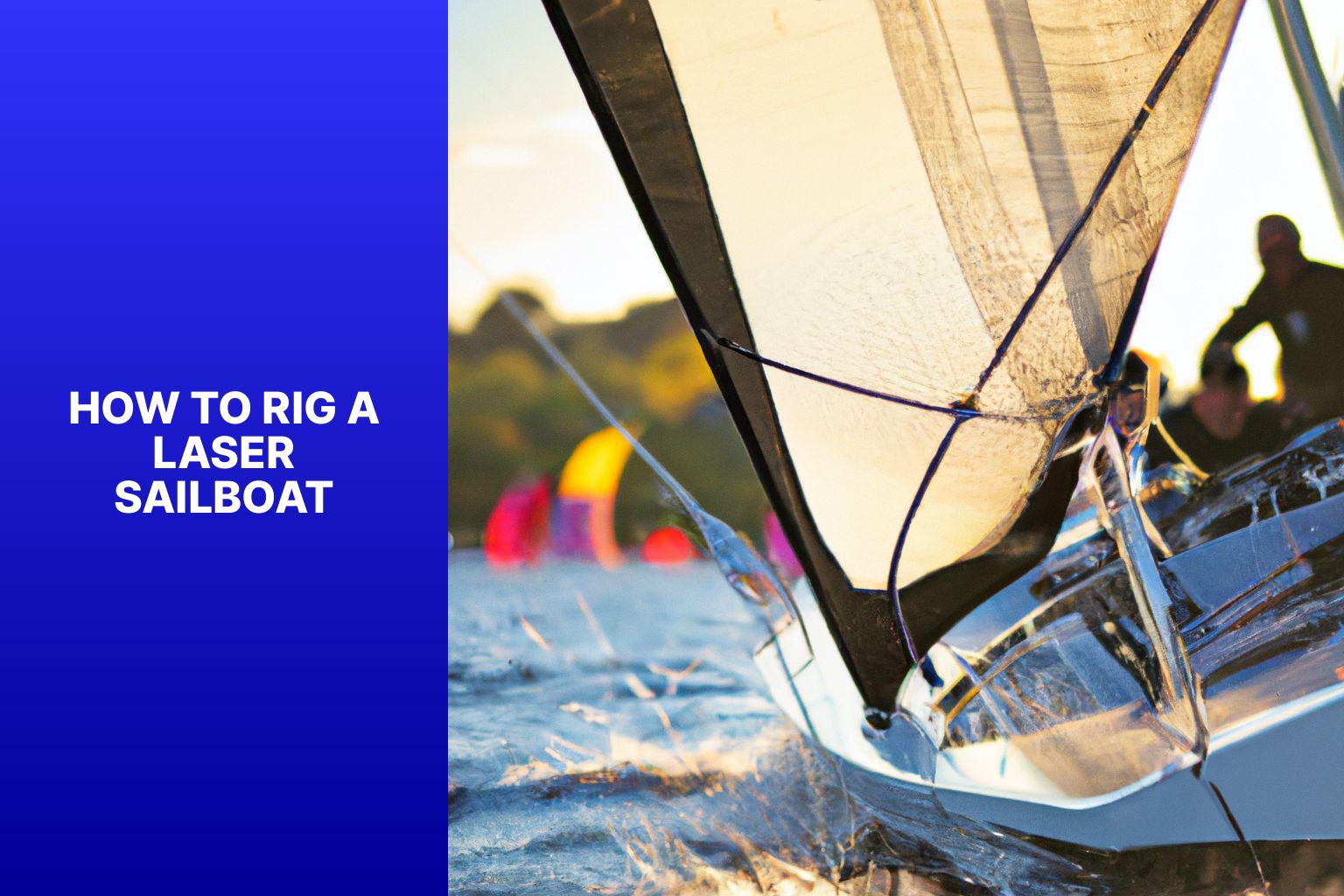
Rigging a Laser sailboat is an essential skill for anyone interested in sailing. Properly rigging a sailboat ensures that all components are securely in place, allowing for a safe and enjoyable sailing experience. This article will provide an introduction to rigging a Laser sailboat, explain the different components involved, and provide a step-by-step guide on how to rig the boat. It will offer tips and best practices to follow while rigging, as well as common mistakes to avoid. Whether you are a beginner or an experienced sailor, mastering the art of rigging a Laser sailboat is crucial for a successful outing on the water.
Key takeaway:
- Rigging a Laser sailboat requires understanding its components: The mast, boom, rigging lines, and sail are essential parts of a Laser sailboat rigging process.
- Following a step-by-step guide ensures proper rigging: Stepping the mast, attaching the boom, securing the rigging lines, and hoisting and adjusting the sail are necessary steps to rig a Laser sailboat correctly.
- Avoiding common mistakes and following best practices is crucial: To rig a Laser sailboat effectively, it is important to be aware of common mistakes and implement best practices for a successful rigging experience.
Understanding the Components of a Laser Sailboat
As we dive into the world of laser sailboats , it’s crucial to understand the nuts and bolts that make up these vessels. In this section, we’ll take a look at the key components that come together to form a laser sailboat . From the sturdy mast to the versatile boom , and the intricate rigging lines to the billowing sail , we’ll navigate through each element, unraveling their significance and how they contribute to a successful sailing experience. Get ready to explore the inner workings of laser sailboats and gain a deeper appreciation for their craftsmanship.
The mast is an essential component of a Laser sailboat as it provides vital support and stability to the sail. Constructed from either lightweight and strong carbon fiber or aluminum, the mast is designed to withstand the powerful forces of wind and water.
When rigging a Laser sailboat, the first crucial step is to carefully insert the mast into the mast step located at the base of the boat’s hull. Once inserted, it is important to raise the mast upright and secure it using a mast clamp or collar for stability.
The next important task is to attach the sail to the mast. This is achieved by raising the sail and securing it using halyards or sail ties. It is vital to properly tension the sail in order to optimize performance and maintain control while sailing.
Throughout the rigging process, it is imperative to regularly check the mast for any signs of damage or wear. It is essential to promptly address any cracks or weaknesses to ensure the safety of both the boat and the sailor while out on the water.
In order to prolong the longevity and enhance the performance of the mast, regular inspections, cleaning, and lubrication of the mast fittings are necessary. This will help prevent corrosion and ensure smooth operation during sailing sessions.
The boom is a necessary part of a Laser sailboat . It is a horizontal spar that extends from the mast. This sturdy pole controls the shape and position of the sail.
Attaching the boom is a crucial step in rigging a Laser sailboat . It involves sliding one end into a fitting on the mast called the gooseneck . The boom is secured with a boom vang , a line that runs from the mast to the boom . This vang controls the tension and angle of the boom , allowing sailors to adjust the sail’s shape and power.
Properly attaching and adjusting the boom is essential for efficient sailing. It allows the sailor to control the sail’s position and shape based on wind conditions. Adjusting the boom optimizes the sail’s power and performance, maximizing speed and maneuverability.
The use of booms in sailing has a long history. It originated from the use of horizontal spars to control the shape of sails on large sailing ships. Over time, booms have become an integral part of smaller sailboats, enhancing sailing performance and control. Nowadays, booms are used in various sailboat designs, including the Laser .
Rigging Lines
To properly rig a Laser sailboat, it is important to understand the components involved, including the rigging lines. Here are the steps to follow:
1. Begin by setting up the main halyard. Attach it to the head of the sail and run it through the top of the mast.
2. Next, secure the main sheet. Attach one end to the boom and run it through the blocks on the back of the boat.
3. Connect the cunningham line. Start by attaching one end to the cunningham eyelet on the front of the mast and run it through the block on the boom.
4. Establish the vang line. Attach one end to the vang fitting on the mast and run it through the block on the boom.
5. Attach the outhaul line. Connect one end to the outhaul fitting on the boom and run it through the outhaul block on the back of the boom.
6. Secure the traveler line. Attach one end to the traveler block and run it through the block on the back of the boat.
By following these steps, you can effectively rig the rigging lines on a Laser sailboat. It is important to check the lines for wear or damage before sailing to ensure a safe and enjoyable experience.
The sail is a crucial component of the Laser sailboat. It efficiently harnesses the power of the wind and propels the boat forward. The sail is carefully constructed using durable and lightweight materials, typically synthetic fibers like Dacron or Mylar .
The sail is securely attached to both the mast and the boom, forming a triangular shape that effectively captures the wind. The size of the sail plays a significant role in the boat’s overall performance. Sails of smaller sizes are ideal for lighter winds, whereas larger sails are more effective in stronger winds.
To properly rig the sail, it is important to securely attach the boom to the mast. Then, the sail should be hoisted up the mast, ensuring correct alignment and tension. The cunningham and outhaul lines can be adjusted to control the shape and tension of the sail.
Taking proper care and maintenance of the sail is crucial for its longevity and optimal performance. Prolonged exposure to direct sunlight should be avoided, as it can cause damage to the sail. Regular inspection for wear and tear is necessary, and any necessary repairs or replacements should be made promptly.
A well-rigged sail is essential for a successful sailing experience, allowing the boat to efficiently capture the power of the wind and maneuver through the water. By familiarizing yourself with the various components and following the correct rigging procedures, you can ensure that your Laser sailboat is ready for an exciting and rewarding adventure on the water.
Step-by-Step Guide on How to Rig a Laser Sailboat
Looking to hit the waves with your Laser Sailboat ? Mastering the rigging process is key to a successful sailing experience. In this step-by-step guide , we’ll walk you through the essentials of rigging a Laser Sailboat . From stepping the mast to hoisting and adjusting the sail, we’ve got you covered. Get ready to set sail with confidence and navigate the waters like a pro !
Stepping the Mast
To properly step the mast of a Laser sailboat, you should follow these steps:
- Position the sailboat upright on a flat surface, ensuring that the bow is facing into the wind.
- Securely insert the mast into the mast step.
- Lift the mast, bringing it into a vertical position.
- Make sure to fully insert the mast into the mast step, securing it firmly.
- Attach the mast base to the mast step by tightening the mast collar or locking mechanism.
- Ensure that the mast is straight and aligned with the centerline of the boat.
- If necessary, tighten any additional mast supports or stays to secure the mast further.
- Before moving forward with rigging the sailboat, double-check all connections to ensure they are secure and stable.
By following these steps, you can guarantee that the mast is properly stepped and securely fixed, providing a strong foundation for rigging the rest of the Laser sailboat.
Attaching the Boom
To attach the boom to a Laser sailboat , follow these steps:
1. Position the boom near the mast , aligning the gooseneck with the mast slot .
2. Slide the boom all the way through the mast slot .
3. Align the holes on the boom fitting with the holes on the mast fitting .
4. Insert the boom bolt through the holes and securely fasten it with a nut if needed.
5. Check that the boom is securely attached and moves smoothly along the mast .
True story: When rigging my Laser sailboat for the first time, I struggled to align the boom fitting with the mast fitting . After a few attempts, I realized I needed to adjust the boom’s position slightly for proper alignment. Once adjusted, the boom slid into place smoothly, and I secured it with the bolt . This experience taught me the importance of attention to detail when rigging a sailboat.
Securing the Rigging Lines
To secure the rigging lines on a laser sailboat, follow these steps:
- Attach the main halyard to the head of the sail.
- Secure the Cunningham line to the front of the mast.
- Attach the outhaul line to the clew of the sail.
- Secure the downhaul line to the tack of the sail.
- Double-check the security of all the rigging lines and make any necessary adjustments for proper tension and alignment.
- Engage the cleats or other fastening mechanisms for the rigging lines to prevent slippage during sailing.
- Check all the rigging lines again to ensure they are secure and properly tensioned before launching the boat.
By securing the rigging lines on a laser sailboat, the sail will be correctly positioned and tensioned for optimal performance on the water.
Hoisting and Adjusting the Sail
In order to hoist and adjust the sail properly, ensure that the halyard is properly attached to the sail and securely fastened . Stand towards the mast and pull on the halyard to raise the sail up the mast. Continue pulling until the sail is fully hoisted to the top of the mast, making sure there are no twists or tangles.
To achieve the desired sail shape based on wind conditions and personal preference, adjust the halyard tension. You can tighten or loosen the halyard to adjust the sail shape. Tightening the halyard will flatten the sail, while loosening it will add more depth .
For different wind conditions, make small adjustments and observe how the sail responds to find the optimal setting. Once the desired sail shape is achieved, secure the halyard by tying it off or using a cleat.
Let me share a true story: One time during a race, while I was hoisting the sail on my Laser sailboat, a sudden gust of wind caught the sail and caused it to billow dramatically . Fortunately, I quickly adjusted the halyard tension and regained control of the sail. This experience taught me the importance of properly hoisting and adjusting the sail to maintain stability and control on the water.
Tips and Best Practices for Rigging a Laser Sailboat
– Start with a well-maintained boat: Check for any damages or wear and tear that may affect the rigging process.
– Properly attach the mast: Use the mast step to securely attach the mast to the boat and ensure proper alignment.
– Attach the boom: Connect the boom to the mast using the gooseneck fitting and make sure it is securely fastened and aligned.
– Attach the mainsheet: Thread the mainsheet through the mainsheet blocks and tightly secure it to the boom for proper control while sailing.
– Attach the sail: Carefully center and align the sail on the mast, securing all sail ties to prevent it from coming loose.
– Tension the rigging: Optimize sailboat performance by adjusting the rigging tension to control the sail shape and maximize speed.
– Check all fittings and lines: Before setting off, inspect all connections to ensure they are secure and in good condition, including the halyard, vang, cunningham, and outhaul.
A sailor followed all the rigging steps meticulously, resulting in a well-rigged laser sailboat that effortlessly glided through the water during a regatta. Their attention to detail paid off as they sailed to victory, impressing their competitors with their skills and precision. This experience highlights the importance of following best practices and tips for rigging a laser sailboat to achieve success on the water.
Common Mistakes to Avoid while Rigging a Laser Sailboat
When rigging a Laser sailboat, it is important to avoid common mistakes that can negatively affect performance and safety. Here are some key points to keep in mind:
1. Correct sail positioning: Make sure to hoist and tension the sail properly. Incorrect positioning can result in poor trim and reduced speed.
2. Adequate rig tension: Proper tension is crucial for optimal performance. Avoiding insufficient tension will prevent a loose sail and decrease control.
3. Mast alignment: Always align the mast with the boat’s centerline. Deviation from this alignment can affect weight distribution and stability.
4. Efficient use of controls: Take the time to familiarize yourself with the cunningham, vang, and outhaul controls. Proper use of these controls will allow for adjustments to changing conditions.
5. Regular maintenance: Regularly inspect the rigging for any signs of wear or damage. Neglecting maintenance can lead to equipment failure and compromise safety.
By avoiding these common mistakes, you will enhance your sailing experience and ensure optimal performance. Remember to practice proper rigging techniques and comply with Laser Class rules.
Some Facts About How To Rig A Laser Sailboat:
- ✅ Rigging a Laser sailboat can be overwhelming for beginners, but with practice and guidance, it becomes easier. (Source: lasersailingtips.com)
- ✅ There is no specific order to rigging a Laser sailboat, as there are many combinations and methods. (Source: lasersailingtips.com)
- ✅ It is recommended to rig up a few times at home before heading out to ensure confidence and familiarity with the process. (Source: lasersailingtips.com)
- ✅ Before heading out, it is important to check the weather forecast and pack all the necessary gear neatly. (Source: lasersailingtips.com)
- ✅ The rigging process begins by laying the boom on the deck and feeding the mainsheet rope through the blocks and eyelets on the boom and cockpit. (Source: lasersailingtips.com)
Frequently Asked Questions
Faqs on how to rig a laser sailboat, 1. how do i assemble the mast of a laser sailboat.
To assemble the mast, slide the bottom of the top half into the top of the bottom half. Then, slide the sail over the mast using the pocket along one side of the sail. Insert the battens into the sail and ensure they are secured.
2. How do I attach the boom and rig the mainsheet?
Attach the front end of the boom to the gooseneck on the mast. Then, walk around to the flapping end of the sail while holding the boom on the gooseneck. Run the outhaul rope through the eye at the end of the boom and cleat it off. Rig the mainsheet by tying one end around the eye on the bottom of the pulley at the end of the boom and running the other end through the traveler on the stern of the boat, through the pulley on the end of the boom, and down through the main block at the front of the cockpit.
3. How do I stand up the mast and attach the boom vang?
To stand up the mast, carefully lift it and place it into the mast step at the front of the laser. Use the middle of the mast for better control and walk forward while pushing the sail up. As for the boom vang, attach it to the bottom of the mast and slide it into the metal clip on the bottom of the boom. Pull down on the hanging line and cleat it off.
4. How do I attach the rudder, tiller, and daggerboard?
Attach the rudder by inserting it into place and securing it with the tiller. Make sure the lift stop clicks into place. For the daggerboard, tie a long loop of elastic to the eye at the end of the dagger board and secure it to the boat.
5. What should I pack and check before rigging a Laser sailboat?
Before rigging, check the weather forecast and pack all necessary gear, including the sail, ropes, foils, and spars. Also, ensure that the hull plug is screwed into the drain hole in the stern of the boat. Check that you have a life jacket and other personal safety equipment.
6. How should I tidy up and secure the boat before launching?
Before launching, tidy up the area and ensure the boat is secure. If needed, detach the trailer or dolly from the car and position it close to the launch area. Double-check that all gear is packed and ready. When in deep water, always put on a rash vest and googles for added protection.
About the author
Leave a Reply Cancel reply
Your email address will not be published. Required fields are marked *
Save my name, email, and website in this browser for the next time I comment.

Latest posts

The history of sailing – from ancient times to modern adventures
History of Sailing Sailing is a time-honored tradition that has evolved over millennia, from its humble beginnings as a means of transportation to a beloved modern-day recreational activity. The history of sailing is a fascinating journey that spans cultures and centuries, rich in innovation and adventure. In this article, we’ll explore the remarkable evolution of…

Sailing Solo: Adventures and Challenges of Single-Handed Sailing
Solo Sailing Sailing has always been a pursuit of freedom, adventure, and self-discovery. While sailing with a crew is a fantastic experience, there’s a unique allure to sailing solo – just you, the wind, and the open sea. Single-handed sailing, as it’s often called, is a journey of self-reliance, resilience, and the ultimate test of…

Sustainable Sailing: Eco-Friendly Practices on the boat
Eco Friendly Sailing Sailing is an exhilarating and timeless way to explore the beauty of the open water, but it’s important to remember that our oceans and environment need our protection. Sustainable sailing, which involves eco-friendly practices and mindful decision-making, allows sailors to enjoy their adventures while minimizing their impact on the environment. In this…

Write a Review

- Create New Wish List
Description
Fun for the whole family
The Ocean Play Pico is an ideal boat for training centres and families. The Pico can be sailed single-handed or two up by adding the jib.
The Pico has a simple reefing system, a spacious cockpit and a high boom, perfect for learning.
The roto-moulded hull provides a robust, buoyant platform that is super stable and creates a great learning environment for novice sailors.
The high boom offers plenty of headroom and makes the self-draining cockpit feel very spacious. Easy to handle and simple to rig, the Pico offers a quick learning curve for single-handed sailing.
Built for family fun, the Pico continues to be a popular sailboat for all ages and abilities. Easy to handle, a snap to rig, the Pico facilitates a rapid learning curve for single-handed sailing. Fun, durable, and confidence inspiring, the Pico is a truly global boat that can be sailed by everyone.
The Pico features: ·Durable dacron sails ·Aluminum spars ·Line kit ·Aluminum foils ·Simple reefing system ·Spacious, self-draining cockpit ·High boom providing ample head room ·Stiff and stable roto-molded hull ·Removable jib and reefing mainsail
- Transport: Cartoppable
- Capacity:1 - 3 People
- Race Level: Club
- Length:11.75FT/3.58M
- Beam:4.53FT/1.4M
- Draft:2.9FT/0.88M
- Sail Area:55.33FT²/5.14M²
- Skill Level: Beginner - Expert
Related Products

Sailboat Dolly Trailer with Laser Pico Dolly Combo
Right-On-Trailer

Dynamic Laser Pico Dolly
Dynamic Dollies

Orange Kayak Flag
Epic Kayaks

Old Style Red Rudder Flag

Tampico 130
Great choice! Your favorites are temporarily saved for this session. Sign in to save them permanently, access them on any device, and receive relevant alerts.
- Sailboat Guide
Laser (International)
Laser (International) is a 13 ′ 8 ″ / 4.2 m monohull sailboat designed by Bruce Kirby and Ian Bruce and built by Performance Sailcraft and LaserPerformance starting in 1970.

Rig and Sails
Auxilary power, accomodations, calculations.
The theoretical maximum speed that a displacement hull can move efficiently through the water is determined by it's waterline length and displacement. It may be unable to reach this speed if the boat is underpowered or heavily loaded, though it may exceed this speed given enough power. Read more.
Classic hull speed formula:
Hull Speed = 1.34 x √LWL
Max Speed/Length ratio = 8.26 ÷ Displacement/Length ratio .311 Hull Speed = Max Speed/Length ratio x √LWL
Sail Area / Displacement Ratio
A measure of the power of the sails relative to the weight of the boat. The higher the number, the higher the performance, but the harder the boat will be to handle. This ratio is a "non-dimensional" value that facilitates comparisons between boats of different types and sizes. Read more.
SA/D = SA ÷ (D ÷ 64) 2/3
- SA : Sail area in square feet, derived by adding the mainsail area to 100% of the foretriangle area (the lateral area above the deck between the mast and the forestay).
- D : Displacement in pounds.
Ballast / Displacement Ratio
A measure of the stability of a boat's hull that suggests how well a monohull will stand up to its sails. The ballast displacement ratio indicates how much of the weight of a boat is placed for maximum stability against capsizing and is an indicator of stiffness and resistance to capsize.
Ballast / Displacement * 100
Displacement / Length Ratio
A measure of the weight of the boat relative to it's length at the waterline. The higher a boat’s D/L ratio, the more easily it will carry a load and the more comfortable its motion will be. The lower a boat's ratio is, the less power it takes to drive the boat to its nominal hull speed or beyond. Read more.
D/L = (D ÷ 2240) ÷ (0.01 x LWL)³
- D: Displacement of the boat in pounds.
- LWL: Waterline length in feet
Comfort Ratio
This ratio assess how quickly and abruptly a boat’s hull reacts to waves in a significant seaway, these being the elements of a boat’s motion most likely to cause seasickness. Read more.
Comfort ratio = D ÷ (.65 x (.7 LWL + .3 LOA) x Beam 1.33 )
- D: Displacement of the boat in pounds
- LOA: Length overall in feet
- Beam: Width of boat at the widest point in feet
Capsize Screening Formula
This formula attempts to indicate whether a given boat might be too wide and light to readily right itself after being overturned in extreme conditions. Read more.
CSV = Beam ÷ ³√(D / 64)
First selected as Olympic class in 1996.
Embed this page on your own website by copying and pasting this code.
- About Sailboat Guide
©2024 Sea Time Tech, LLC
This site is protected by reCAPTCHA and the Google Privacy Policy and Terms of Service apply.
Free Shipping Over $99* - 366 Day Returns - Dedicated Customer Support

- Call Us +1-503-285-5536
- Sign in & Register
- Recently Viewed
Laser Sailing

Proudly Supporting Laser Sailors Since 2005
West Coast Sailing is North America's #1 source for Laser sailors, offering parts, apparel, and support for since 2005. Laser sailing has been a core part of our business since day one, and we've had the honor of working with sailors around the world. Our connections to the community include annual support of the North American class association, Columbia Gorge Racing Association (local racing venue in the Gorge), west coast districts including District 22, District 24, and District 25, and numerous events around the country. We actively stock new ILCA sailboats from Ovington, offer charters at regional events, and have an industry leading selection of one design parts, new sails, spars, upgrades, covers, dollies, and all of the latest apparel from top brands. Whether you're an Olympic hopeful, active weekend warrior, or recreational sailor, you can trust our team to help you get out on the water and discover why thousands of sailors around the world choose to sail in this great class.
Why West Coast Sailing?
Actively supporting Laser sailors since 2005 - 15+ years! Industry leading selection of the best boats, parts, sails, and accessories with thousands of items in stock. Dedicated team of dinghy sailors to answer your questions. Sponsoring the class association, district series, and events around the country. Fast, free shipping on most orders.
Your Source for Laser Parts & Accessories
LASER SAILS + FREE #s/INSTALL
Laser custom rigging, laser spars, parts, & accessories, rigging guides & advice, laser youtube videos, rigging & setup reference photos.
Laser District & Regatta Support
DISTRICT 24 GRAND PRIX - Northern California
District 24 is one of most active ILCA/Laser districts in North America and includes sailors from California north San Luis Obispo to Oregon and all of Nevada (except Las Vegas). The District 24 Laser Grand Prix is an annual series of regattas hosted by various sailing clubs. West Coast Sailing is a multi year sponsor of the series through 2022.
Grand Prix Event Page - Click Here
DISTRICT 22 GRAND PRIX - Pacific Northwest
West Coast Sailing is proud to be the primary sponsor of the new ILCA-NA District 22 Grand Prix, a series of ILCA events in the Pacific Northwest. Thanks to the Columbia Gorge Racing Association for assisting in organizing this series!
Notice of Race and Results - Click Here
DISTRICT 25 SUPPORTING SPONSOR - Southern California
In addition to support for District 22 and District 24, West Coast Sailing is a key supporter of sailors in District 25 in Southern California.
ILCA/Laser Sailing Resources
Laser vs ILCA Explained How to Update and Restore an Old Laser Guide to ILCA/Laser Rig Sizes ILCA Rigging Videos on YouTube
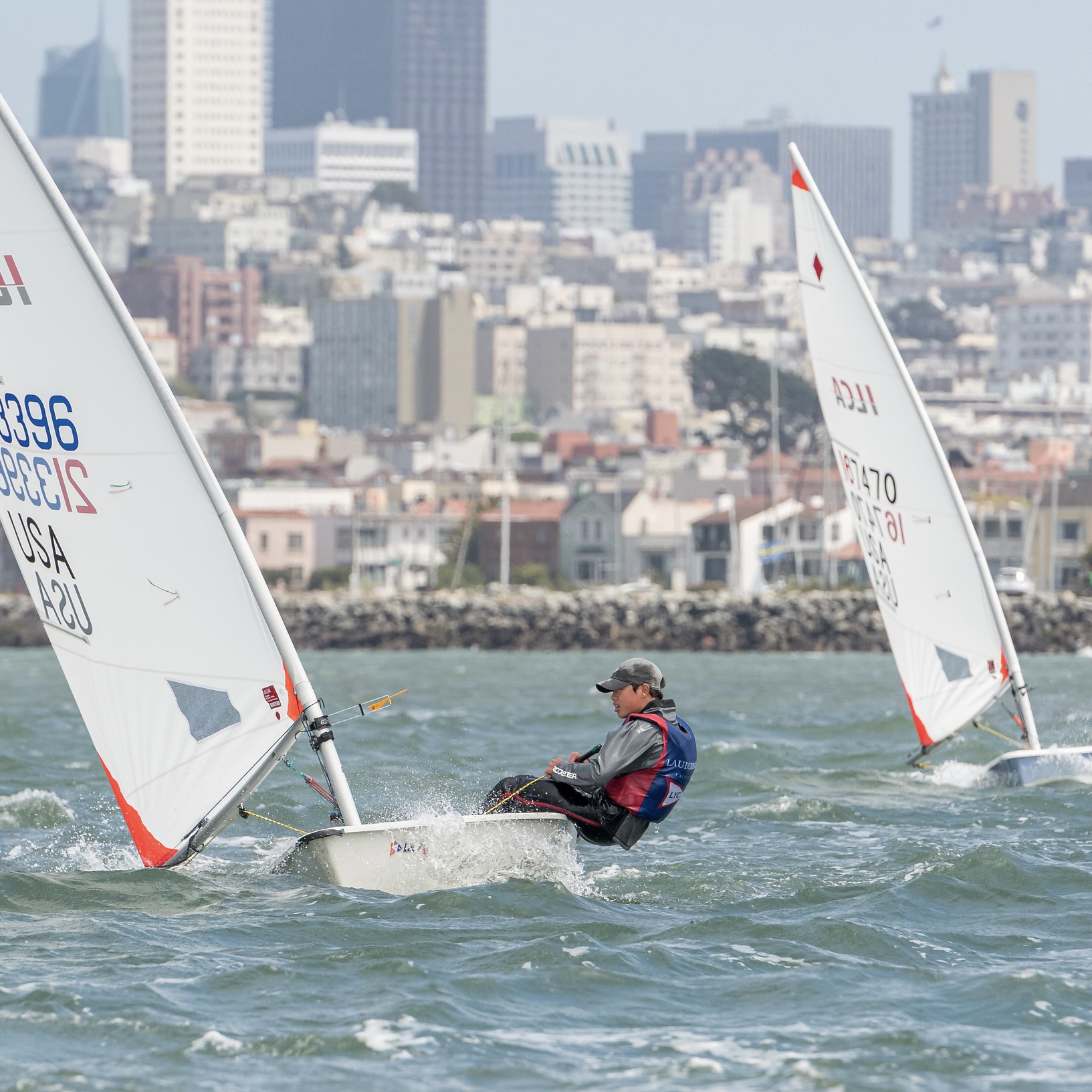
PARTS DIAGRAM
Rigging manual.
ILCA / Laser Line Guide & Rigging Upgrades
Blog Post: A Guide to Restoring an Old Laser
Guide: Rivets for ILCA / Laser Spars
Guide: ILCA / Laser Rig & Sail Sizes
Subscribe To Our Newsletter
Sign up for our newsletter to receive exclusive discounts, new product announcements, and upcoming sales.
You are using an outdated browser. Upgrade your browser today or install Google Chrome Frame to better experience this site.

To have your fleet featured here, send a short story about your fleet, all fleet members names, and a few current action photos of where your fleet sails to RC Laser Class Secretary, Nick Mortgu at [email protected] .
Central and Midwest Canada Region
- Willowbrook, IL – Lake Hinsdale Village Yacht Club
- Frankfort, MI – Crystal Lake Yacht Club
Northeast & Eastern Canada Region
- Collingwood, Canada – Collingwood Ontario Laser Fleet
- Canandaigua, NY – Canandaigua RC Laser Fleet
- Darien, CT – Noroton Yacht Club RC Laser Fleet
- Plainville, CT – Paderewski Model Yacht Club
- North Kingstown, RI – Wickford Harbor Mudheads
- Watch Hill, RI – Watch Hill RC Laser Fleet
- Stafford, NH – Bow Lake Sailing MYC
Mid-Atlantic Region
- Ocean City, NJ – South Jersey Model Yacht Club
- Perth Amboy, NJ – Raritan Yacht Club RC Laser Fleet
- Spring Lake, NJ – Spring Lake Marbleheaders MYC
- Oxford, MD – Oxford RC Laser Fleet
- Pocono Pines, PA – Lake Naomi Club
- Virginia Beach, VA – Tidewater RC Laser Fleet
- Williamsburg, VA – Kingsmill Model Yachting Association
Southeast Region
- Raleigh, NC – Triangle Model Yacht Club
- Mt. Juliet, TN – Lake Providence RC Club
- Charleston, SC – Charleston Model Yacht Club
- Bonita Springs, FL – Model Sailing Club of Village Walk
- Coral Springs, FL – Sabal Pines MYC
- Marco Island, FL – Marco Island RC Laser Fleet
- Punta Gorda, FL – Sun Coast Model Sailing Club
- Sarasota, FL – Sarasota Model Yacht Club
- St. Petersburg, FL – Golden Triangle Club
- Abaco, Bahamas – Marsh Harbor RC Laser Fleet
South Central Region
- Mandeville, LA – Mandeville Bay Racing Club
- Corpus Christi, TX – Coastal Bend Model Yacht Club
- San Antonio, TX – Woodlawn Sailing Club
Western & Western Canada Region
- Vancouver Island, Canada – Nanaimo RC Laser Fleet
- Astoria, OR – Astoria Yacht Club
- Crestline, CA – Lake Gregory Yacht Club
- Penn Valley, CA – Lake Wildwood Lasers
- Redwood City, CA – Redwood City RC Laser Fleet

- Ocean Play Bahia
- Ocean Play Bug
- Ocean Play Pico
- Ocean Play Vago
- Laser Bahia
- ILCA dinghy
- Optimist - Race
- Optimist - School
- Bung - Drain plug
- Complementary parts
- Fairleads - Deck bushes
- Furlers - Swivels
- Gudgeon fittings
- Hatch covers
- Lacing eye strap
- Swivel cleats and Jammers
- Tiller extensions
- Tension gauges
- Wind Indicators
- Boat repair
- Maintenance
- Accessoires
- Buoyancy aids
- Coastal gear
- Hooded towel
- Lycra - Spandex
- Hiking straps
- Sailcenter Beanie
- Sailcenter Hoody
- ILCA Dinghy
- Control lines
- Optimist School
- Country code
- Laser - ILCA
- Laser Cascais
Sailcenter is official distributor of Laser Performance sailboats, we have new Laser sailboats and Laser sailboat spare parts in stock as well used Lasers.
Laser XD Standard
- Ready to sail
- Colour ice blue
- Weight range Standard: Over 70 kg
Laser XD 4.7
- Weight range 4.7: below 60 kg
Laser XD Radial
- Weight range Radial: 55 - 80 kg
Save products on your wishlist to buy them later or share with your friends.
- Vessel Reviews
- Passenger Vessel World
- Offshore World
- Tug and Salvage World
- Maritime Security World
- Specialised Fields
- Marine Projects World
- Small Craft World
- Tanker World
- Dry Cargo World
- Boxship World
- Aquaculture World
- Trawling World
- Longlining World
- Seining World
- Potting World
- Other Fishing Methods
- Regulation & Enforcement
- Feature Weeks
- Classifieds
- Book Reviews
VESSEL REVIEW | Sinichka – Electric commuter boats designed for Russia’s Moskva River
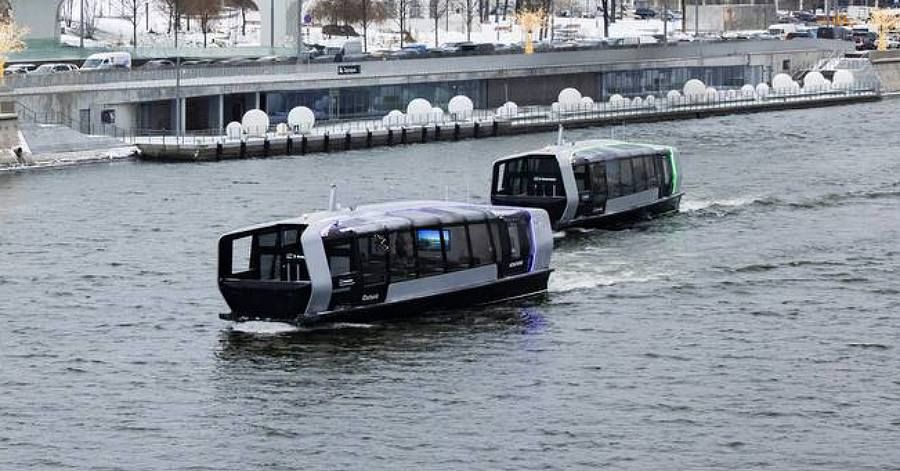
A series of three new electric monohull commuter ferries have already begun operational sailings on the Moskva River in the Russian capital Moscow.
Built by Russian shipyard Emperium, sister vessels Sinichka , Filka , and Presnya – all named after rivers in Moscow – are being operated by the Moscow Department of Transport and Road Infrastructure Development (Moscow Deptrans). They are the first units of a planned fleet of 20 vessels that will serve the capital city and other nearby communities. The new ferry system will be the water transport system to be operated on the Moskva River in 16 years.
Each vessel has a welded aluminium hull, an LOA of 21 metres, a beam of 6.2 metres, a draught of only 1.4 metres, a displacement of 40 tonnes, and capacity for 80 passengers plus two crewmembers. Seating is available for 42 passengers on each ferry, and the main cabins are also fitted with USB charging ports, wifi connectivity, tables, toilets, and space for bicycles and scooters. The cabin layout can be rearranged to allow the operator to adjust the distances between the seats and to install armrests of varying widths.
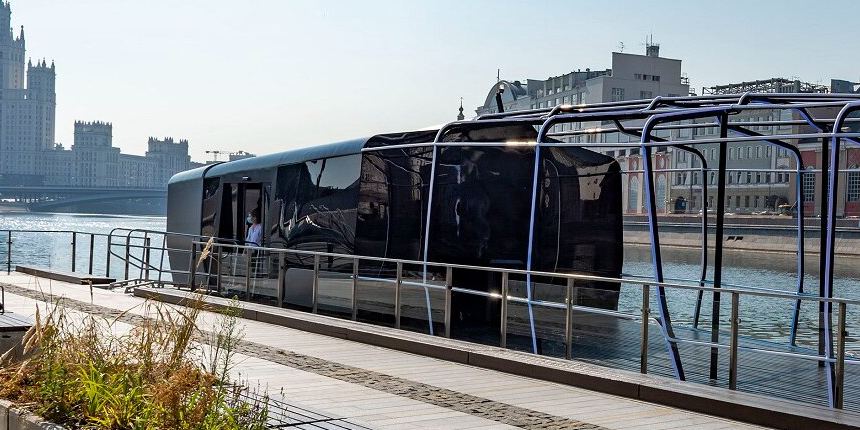
An open upper deck is also accessible to passengers and is the only area on each ferry where smoking is allowed.
The ferries are all of modular construction with each ferry’s wheelhouse, main cabin, and other structural elements being built as complete, separate components. This enables the ferries to be easily dismantled for transport to anywhere in Russia by rail and then quickly re-assembled within seven days.
The ferries are also ice-capable. Recently completed operational trials on the Moskva showed that the vessels can also easily navigate under mild winter conditions with broken surface ice, though year-round operations are planned for the entire fleet.
The ferries are each fitted with 500kWh lithium iron phosphate battery packs that supply power to two 134kW motors. This configuration can deliver a maximum speed of 11.8 knots, a cruising speed of just under 10 knots, and a range of 150 kilometres.
Emperium said the transfer of rotation of electric motors to the propeller is carried out by direct drive. As a propulsion installation, a pulling rotary propeller-steering column with double screws is used. The installation of double pulling screws, with similar power, allows an operator to increase the efficiency of the propulsion system to deliver a slightly higher speed or to reduce energy consumption. This arrangement also provides the ferries with enhanced manoeuvrability necessary for navigating in close quarters.
The batteries themselves have projected service lives of 10 to 12 years and are fitted with safety features such as built-in fire extinguishers and gas vents. Quick-disconnect features allow the batteries to be easily removed for replacement or maintenance.
Some of our readers have expressed disquiet at our publication of reviews and articles describing new vessels from Russia. We at Baird Maritime can understand and sympathise with those views. However, despite the behaviour of the country’s leaders, we believe that the maritime world needs to learn of the latest developments in vessel design and construction there.
Click here to read other news stories, features, opinion articles, and vessel reviews as part of this month’s Passenger Vessel Week.
Related Posts

Baird Maritime
Tags: Emperium Filka Moscow Moscow Department of Transport and Road Infrastructure Development Moskva River Presnya Russia Sinichka WBW newbuild
- Previous VESSEL REVIEW | Ferry Rokko – Second 194m Ro-Pax for Miyazaki Car Ferry
- Next Brighton man to be charged for illegal abalone haul

Baird Maritime , launched in 1978, is one of the world's premier maritime publishing houses.
The company produces the leading maritime new portal BairdMaritime.com , home of the world famous Work Boat World, Fishing Boat World, Ship World, Ausmarine, and Commercial Mariner sub-sites, and the industry-leading ship brokerage platforms WorkBoatWorld.com and ShipWorld.com .
Contact us: [email protected]
© Copyright - Baird Maritime
- Terms & Conditions
- Advertise with Baird Maritime
- Submit News/Leads
THE 10 BEST Moscow Boat Rides & Cruises
Boat rides & cruises in moscow.
- Boat Rentals
- Scuba & Snorkeling
- Fishing Charters & Tours
- Water Sports
- Stand-Up Paddleboarding
- Surfing, Windsurfing & Kitesurfing
- Kayaking & Canoeing
- Waterskiing & Jetskiing
- Parasailing & Paragliding
- River Rafting & Tubing
- Dolphin & Whale Watching
- Speed Boats Tours
- Submarine Tours
- 5.0 of 5 bubbles
- 4.0 of 5 bubbles & up
- 3.0 of 5 bubbles & up
- 2.0 of 5 bubbles & up
- 3rd Transport Ring (TTK)
- District Central (TsAO)
- Garden Ring
- District Northern (SAO)
- Good for Big Groups
- Good for Couples
- Good for a Rainy Day
- Budget-friendly
- Good for Kids
- Hidden Gems
- Honeymoon spot
- Good for Adrenaline Seekers
- Adventurous
- Things to do ranked using Tripadvisor data including reviews, ratings, photos, and popularity.

1. Flotilla Radisson Royal

2. Moscow River Boat Tours

3. Sup-Club

4. Akvanavt Diving Centre

5. Diving Center Crocus City Oceanarium

6. CheapRussia Tours
7. Kite School Kiteclass

8. SUP Center

9. Erwin. Reka
11. Easy Russia Tour Guide
12. Lovely Russia Tours

13. Capital River Boat Tours - Moscow Centre

14. Alfa Centr
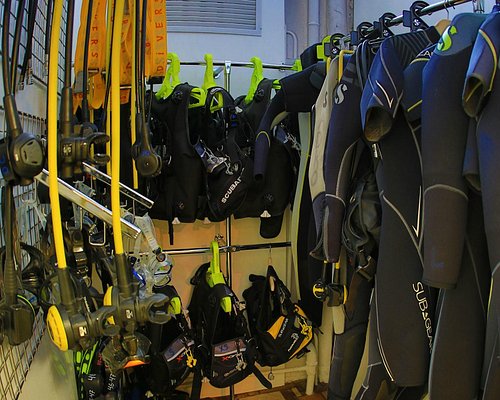
15. Diving Club Divers
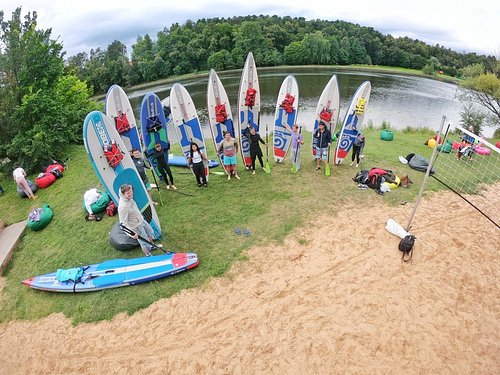
16. Sup Outdoor

17. MORE MOSCOW
19. Soho Sailing Style

20. Mosparokhodstvo
21. Dive-Project

22. Diving Center Crocodile

24. Kosinskiy Children Marine Club

25. Kayak Moscow
26. DIVECLUB CHE

27. FLOW Moscow

28. Moswake

29. Morskiye Volki

30. S-cruises
What travelers are saying

- CheapRussia Tours
- Easy Russia Tour Guide
- Lovely Russia Tours
- MORE MOSCOW
- Insider Moscow Tours
- Flotilla Radisson Royal
- Moscow River Boat Tours
- Capital River Boat Tours - Moscow Centre
- Diving Center Crocus City Oceanarium

COMMENTS
I would say you are indangering yourself. Especially if you have been sailing for 2 weeks only. You need atleast 3 more years of experience to be able to handle sailing in the ocean. There is a reason you dont see many ocean racing regattas in lasers. Apr 6, 2008. #3.
Standard - 7.1sqm sail for heavier and more athletic sailors. Radial - 5.1sqm sail for women, and lighter sailors. 4.7 - 4.7sqm for youth and lighter females. The Laser is a true sailing phenomenon. With nearly 200,000 boats in 140 countries, it is clearly the world's most popular adult and youth racing sailboat.
Laser training before the worlds England
BAHIA - Production now started at Ocean Play - Available Spring of 2023 - Pricing TBD. Row, sail, or motor. The Bahia was designed with stability, safety and performance in mind. It was created for leisure and ease of use, but not at the expense of performance. ... More than just a sailboat: The multifunctional Laser Bahia can be sailed ...
The Sunfish combines easy rigging and manageability for a comfortable and hassle-free sailing experience. This is the sailboat loved by all. Designed in 1952 as the ultimate beach craft, the Sunfish sailboat is still a favourite with all ages. This maintenance free boat holds its resale value thanks to its robust construction, highlighted by hard chines and a flat underbody.
Fifty years of Laser sailing. Published on December 1st, 2021. When the Laser boat emerged in the 1970s, it was a gateway drug to the world of sailing. Go anywhere, launch anywhere, race anywhere ...
Sailing Chandlery have boats readily available and can tailor a package to suit your sailing needs. The easiest way to get started is to review the Laser boats for sale on our website along with prices and then give us a call to tailor your package. You can call us on 07793 953564.
Laser Standard / MK2 / ILCA 7. This is the most common Laser rig size, and the original rig on the boat when it was designed. It features a 7.06 square meter sail (about 76 square feet). In 2018, the Laser Class approved a new 'Standard' sail, which is referred to as the 'MKII' or 'Mark 2' to distinguish it from the first version.
Laser Standard / MK2 / ILCA 7. This is the most common Laser rig size, and the original rig on the boat when it was designed. It features a 7.06 square meter sail (about 76 square feet). In 2018, the Laser Class approved a new 'Standard' sail, which is referred to as the 'MKII' or 'Mark 2' to distinguish it from the first version.
Thanks for visiting Tips. - Body Positioning: Laser sailing requires careful attention to body positioning. Make sure your body is balanced in the boat. Keep your weight centered when sailing upwind, and hike out (lean out over the side of the boat) as much as possible when required to help control the boat's heel and maximize speed.
To properly rig a Laser sailboat, it is important to understand the components involved, including the rigging lines. Here are the steps to follow: 1. Begin by setting up the main halyard. Attach it to the head of the sail and run it through the top of the mast. 2.
The Ocean Play Pico is an ideal boat for training centres and families. The Pico can be sailed single-handed or two up by adding the jib. The Pico has a simple reefing system, a spacious cockpit and a high boom, perfect for learning. ... Sailboat Dolly Trailer with Laser Pico Dolly Combo. Right-On-Trailer. $1,649.00 - $1,749.00
Laser SB3. The SB3 (stands for sportboat for three people), hugely popular in Europe, made its American debut at the Annapolis sailboat show earlier this month. It seems to have hit the elusive target that sportboat designers shoot for a fun, fast, durable, and reasonably affordable raceboat. To that end, there s some carbon used in the ...
Laser (International) is a 13′ 8″ / 4.2 m monohull sailboat designed by Bruce Kirby and Ian Bruce and built by Performance Sailcraft and LaserPerformance starting in 1970. ... better suited for ocean passages >2: better suited for coastal cruising. Notes. First selected as Olympic class in 1996.
Actively supporting Laser sailors since 2005 - 15+ years! Industry leading selection of the best boats, parts, sails, and accessories with thousands of items in stock. Dedicated team of dinghy sailors to answer your questions. Sponsoring the class association, district series, and events around the country. Fast, free shipping on most orders.
Ocean City, NJ - South Jersey Model Yacht Club. Perth Amboy, NJ - Raritan Yacht Club RC Laser Fleet. Spring Lake, NJ - Spring Lake Marbleheaders MYC. Oxford, MD - Oxford RC Laser Fleet. Pocono Pines, PA - Lake Naomi Club. Virginia Beach, VA - Tidewater RC Laser Fleet. Williamsburg, VA - Kingsmill Model Yachting Association.
Laser XD Radial. Ready to sail. Colour ice blue. Weight range Radial: 55 - 80 kg. €5,495.00. Add to cart. Showing 1-3 of 3 item (s)
Consider, though, that the typical summertime coastal cruiser will rarely encounter the wind and seas that an ocean going yacht will meet. Numbers below 20 indicate a lightweight racing boat, small dinghy and such; 20 to 30 indicates a coastal cruiser; 30 to 40 indicates a moderate bluewater cruising boat; 40 to 50 indicates a heavy bluewater boat;
About Us. Baird Maritime, launched in 1978, is one of the world's premier maritime publishing houses.. The company produces the leading maritime new portal BairdMaritime.com, home of the world famous Work Boat World, Fishing Boat World, Ship World, Ausmarine, and Commercial Mariner sub-sites, and the industry-leading ship brokerage platforms WorkBoatWorld.com and ShipWorld.com.
Walking tour around Moscow-City.Thanks for watching!MY GEAR THAT I USEMinimalist Handheld SetupiPhone 11 128GB https://amzn.to/3zfqbboMic for Street https://...
Explore the scenic and historic attractions of Moscow from the water with the best boat tours and cruises. Enjoy the views of the Kremlin, the Cathedral of Christ the Savior, and the Sparrow Hills on a relaxing or informative boat ride. Or, spice up your trip with some water sports and activities in Moscow. Find out more on Tripadvisor.
Consider, though, that the typical summertime coastal cruiser will rarely encounter the wind and seas that an ocean going yacht will meet. Numbers below 20 indicate a lightweight racing boat, small dinghy and such; 20 to 30 indicates a coastal cruiser; 30 to 40 indicates a moderate bluewater cruising boat; 40 to 50 indicates a heavy bluewater boat;
The exhibitors of Photonics 2023 included leading manufacturers of laser and optical products, dealers of major companies, research institutes, and leading educational institutions of Russia. It should be noted that the number of exhibitors from China exceeded the pre-pandemic level, with 25 companies demonstrating their products this year.